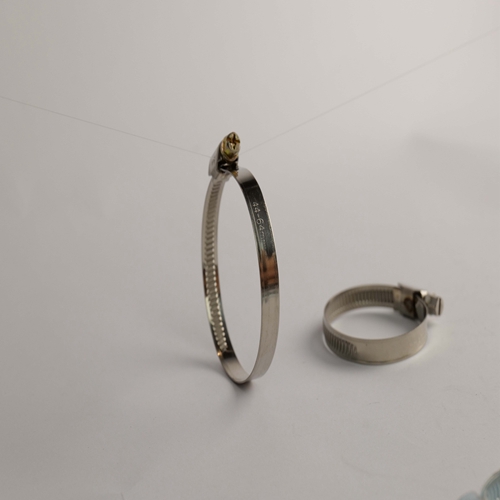- Phone:+86-17331948172 +86-0319-8862898
- E-mail: inquiry@puxingclamp.com
ਦਸੰ. . 07, 2024 09:12 Back to list
constant tension spring hose clamps factories
Understanding Constant Tension Spring Hose Clamps and Their Manufacturing
In the world of industrial components, constant tension spring hose clamps play a pivotal role in ensuring secure and reliable connections for various applications. These clamps are especially critical in automotive, plumbing, and HVAC systems where maintaining the integrity of hoses under varying pressures and temperatures is essential. This article delves into the intricacies of constant tension spring hose clamps, examining their design, functionality, and the factories that manufacture them.
What Are Constant Tension Spring Hose Clamps?
Constant tension spring hose clamps are specialized devices designed to maintain a consistent pressure on hoses as they expand and contract with temperature fluctuations. Unlike traditional hose clamps, which can become loose over time due to changes in pressure or environmental conditions, constant tension clamps utilize a spring mechanism that automatically adjusts to the changes in diameter of the hose. This feature ensures that the clamp remains securely fastened, preventing leaks and potential hazards.
The design typically involves a band made of high-quality materials resistant to corrosion and fatigue, ensuring longevity even in harsh environments. The spring mechanism that characterizes these clamps is usually constructed from stainless steel, allowing for a balance between strength and flexibility. The clamp's profile, additionally, is designed to distribute force evenly along the hose, minimizing the risk of damage from localized pressure points.
How Do They Work?
The operational principle of constant tension spring hose clamps is relatively straightforward. As a hose heats up, it expands; conversely, it contracts as it cools. The spring inside the clamp compensates for these changes by adjusting its tension automatically. This mechanism provides a consistent grip throughout the life of the clamp, which is critical in applications where pressure changes can lead to catastrophic failures if not managed appropriately.
In practical terms, using a constant tension clamp can enhance the reliability of systems where hose integrity is paramount. For example, in automotive engines, these clamps can prevent fluid leaks that might otherwise lead to engine failure or unsafe operating conditions. In plumbing, they offer assurance against water leaks, which can cause significant damage and costly repairs.
Manufacturing Process
constant tension spring hose clamps factories

The manufacturing of constant tension spring hose clamps involves several critical steps. Factories specializing in these components typically begin with the selection of high-quality raw materials, such as stainless steel or other alloys known for their durability and resistance to environmental factors.
1. Material Preparation High-grade materials are sourced and prepared for the manufacturing process. This may involve cutting the steel into strips that will be formed into the clamp shape.
2. Forming the Clamp The metal strips are then formed into the desired clamp shape using specialized machinery. This step requires precision, as the fit must ensure that the clamp can effectively apply constant pressure without being overly tight, which could damage the hose.
3. Adding the Spring Mechanism After the basic clamp structure is formed, the spring mechanism is integrated. This is a crucial step, as the tension and resilience of the spring will dictate the effectiveness of the clamp's performance.
4. Finishing Touches Finally, the clamps undergo finishing processes such as polishing and coating. These treatments enhance corrosion resistance and improve the overall appearance of the product. Quality control checks are also conducted to ensure that each clamp meets the required specifications and standards.
5. Packaging and Distribution Once manufactured, the clamps are packaged and prepared for distribution. Factories often keep a range of sizes and designs in stock to meet diverse customer needs.
Conclusion
In conclusion, constant tension spring hose clamps are essential components within various systems, ensuring secure and dependable connections. Their innovative design and automatic tension adjustment provide a solution to one of the persistent challenges in hose management—maintaining a tight grip under changing conditions. The factories that produce these clamps play a crucial role in the industrial supply chain, providing high-quality, reliable products that meet the demanding standards of modern engineering and manufacturing. As industries continue to evolve, the importance of reliable components such as constant tension spring hose clamps remains paramount, underscoring the indispensable nature of these manufacturing processes.
-
Large Stainless Steel Adjustable American Type Hose Clamp - Hebei Pux Alloy Technology Co., Ltd.
NewsAug.06,2025
-
High Quality Steel Midsole - EN Standard for Safety Shoes
NewsAug.06,2025
-
Large Stainless Steel Adjustable American Type Hose Clamp - Hebei Pux Alloy Technology|[Corrosion Resistance]&[Adjustable Design]
NewsAug.06,2025
-
Large Stainless Steel Adjustable American Type Hose Clamp - Hebei Pux Alloy Technology Co., Ltd
NewsAug.05,2025
-
Large Stainless Steel Hose Clamp - Hebei Pux Alloy Technology Co., Ltd | Corrosion Resistance, Adjustable Design
NewsAug.05,2025
-
Large Stainless Steel Adjustable American Type Hose Clamp - Hebei Pux Alloy Technology Co., Ltd | Corrosion Resistance&Adjustable Design
NewsAug.05,2025




